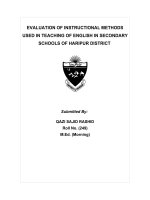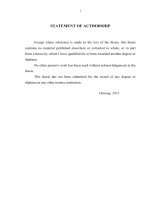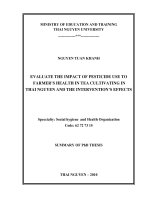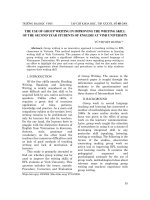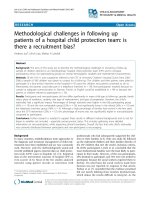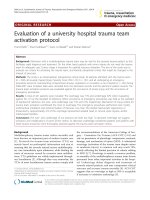Evaluation of institutional method used in teaching of english in secondary schools of Haripur District
Bạn đang xem bản rút gọn của tài liệu. Xem và tải ngay bản đầy đủ của tài liệu tại đây (318.89 KB, 69 trang )
EVALUATION OF INSTRUCTIONAL METHODS
USED IN TEACHING OF ENGLISH IN SECONDARY
SCHOOLS OF HARIPUR DISTRICT
Submitted By:
QAZI SAJID RASHID
Roll No. (249)
M.Ed. (Morning)
INSTITUTE OF EDUCATION AND RESEARCH
UNIVERSITY OF PESHAWAR
(2005)
2
EVALUATION OF INSTRUCTIONAL METHODS
USED IN TEACHING OF ENGLISH IN SECONDARY
SCHOOLS OF HARIPUR DISTRICT
Submitted By:
QAZI SAJID RASHID
Roll No. (249)
M.Ed. (Morning)
Submitted to:
Dr. IFFAT ARA HUSSAIN
INSTITUTE OF EDUCATION AND RESEARCH
UNIVERSITY OF PESHAWAR
(2005)
2
Dedication
Dedicated to my
Honorable parents
whose sincere prayers,
and guidance proved a
beacon for me have
made me extremely
successful in each and
every sphere of this
mortal life.
APPROVAL SHEET
The thesis entitled “Evaluation of instructional method used in teaching
of English In secondary schools of Haripur District.
Accepted by the faculty of the institute of educational and research
university of Peshawar, in partial fulfillment of the requirements for master of
education degree.
Research Conducted By
QAZI SAJID RASHID
M. Ed (Morning)
Class No (249)
Supervised by:
DR. IFFAT ARA HUSSAIN
Internal Examiner ___________________
External Examiner ___________________
ACKNOWLEDGMENTS
With a deep sense of gratitude the researcher is thankful to God, the most
beneficent and merciful for enabling him to complete the task.
The researcher is extremely thankful to Professor. Dr. Iffat Ara Hussain
whose guidance remained a source of immense encouragement throughout this
study. She was very sincere in her advice and generous in sparing time for it. She
was an unfailing source of inspiration and encouragement. Her insightful
suggestions paved the way to this stage. She deserves deep gratitude from the
researcher.
Thanks is also due to all the librarians of main library of university of
Peshawar, librarians of I.E.R for their cooperation which was found valuable to
this study and all the principals, English teachers, colleagues and friends who gave
me their precious time and provided data for this study.
It will be a gross mistake if I did not mention the name of my sincere
friends Asad Ali, Mr. Sher Mohammad and Mr. Rabnawaz who also extended
their help in the completion of this research topic. The researcher is really grateful
to them.
i
ABSTRACT
The purpose of this study is to evaluate the methodology of teaching
English in secondary schools at District Haripur and to provide suggestions for its
improvement. The study was conducted in 12 Govt: boys High Schools at Haripur
District, by serving a Questionnaire comprising 30 questions. The questions were
about teacher’s academic and professional qualifications, experience, teaching
methods, number of students in English class, size of class rooms, standard of
English, cooperation by the parents and cooperation by the others teachers. The
questionnaire was served to 40 teachers of the 12 Government Boys High Schools
of Haripur and all the questioners were received back. Data was compiled and
analyzed. All the 12 schools are cognizant of the fact that they prefer to retain
English as a medium of instructions. All the teachers are trained but still all of
them can’t use direct method of Teaching English. The reason is that most of them
haven’t attended any refresher courses. The facility of AV aids and language labs
are not available in the schools. There is also found some dissatisfaction with the
curriculum. On the basis of these findings, recommendations were made.
ii
TABLE OF CONTENTS
Chapter # Pages
No
ACKNOWLEDGMENT i
ABSTRACT ii
I INTRODUCTION 1-3
II
1.1 Background of the Study
1.2 Statement of the Problem
1.3 Objectives of the Study
1.4 Significance of the Study
1.5 Hypothesis
1.6 Delimitation of the Study
REVIEW OF RELATED LITERATURE
2.1 Why second Language
2.2 Teaching Methodology
2.3 Grammar Translation Method
2.4 Direct Method
2.5 The Audio Lingual Method
2.6 The Oral Approach & Situational Language Teaching
2.7 Factor Influencing the Teaching of second Language
2.8 The Pupil Factor
2.9 The Teacher Factor
2.10 External Factor
1
2
2
2
3
3
4-24
4
5
6
8
10
11
12
13
14
16
iii
III
IV
2.11 Factor Influencing the Learning of second Language
2.12 The Role of Style & Strategies in Secondary
Language Learning
2.13 Classroom Procedure for Reading in Large Classes
2.14 Pre-Writing Activities
2.15 Teacher Development
2.16 Teaching of Poetry
2.17 Steps in Teaching Poem
2.18 The Place of Syllabus
2.19 Choosing & Integrated Syllabi
METHOD AND PROCEDURE
3.1 Nature of the Study
3.2 Population
3.3 Sampling
3.4 A Rational for the Questionnaire
3.5 The Construction of Questionnaire
3.6 Administration of the Questionnaire
3.7 Personal Visit
3.8 Analysis of the Data
TABULATION & INTERPRETATION OF DATA
16
17
18
19
20
20
21
23
24
27-29
27
27
27
28
28
28
28
28
30-46
iv
V
FINDING, CONCLUSION, RECOMMENDATION
Finding
Conclusion
Recommendation
Appendix (A)
Appendix (B)
Bibliography
47-52
47
50
52
54
55
58
v
CHAPTER NO 1
INTRODUCTION
1.1 BACKGROUND OF THE STUDY
The study of English Language in the Indo-Pak subcontinent can be traced
back to the arrival of East India Company in this region. However this study
became a part and parcel of educational enterprise only when Britain, after
capturing India, declared English as the language of office and court: English was
included in the formal school curricula and white collar jobs were offered only to
those who knew English.
During the period of British rule, English firmly established itself in the
sub-continent as the language of office, court, administration and as medium of
instruction in the schools and colleges. It also succeeded in deep rooting itself as
the common mode of communication among the different parts of the sub-
continent.
At the time of independence in 1947 English was the office and court
language in Pakistan and it continued to retain its same position due to lack of
common communication link between the two wings of Pakistan with the
exception of some urban areas; Urdu was not followed in the East Pakistan and
Bangali was quite alien in the west Pakistan. Under these situations, the prevailing
position was English was accepted a matter of emergency need and it served as
lingua- Franca between the East and West wings of Pakistan.
In the modern age of science and technology, English has emerged as an
international language. It is the language of science, technology, commerce and
trade and the only most widely used means of international communication link.
At present, it has become so important that no country of world can ignore
it. Particularly in the Pakistan, where it is already a medium of instruction at
1
higher level, we can not afford to ignore it. In such a situation the study of English
at the secondary level becomes more and more important as it is the formation
stage for the higher studies.
1.2 STATEMENT OF THE PROBLEM
The study in hand is made to evaluate the instructional methods used in
teaching of English at the secondary level in District Haripur.
1.3 OBJECTIVES OF THE STUDY
The following are the objectives of the study.
1. To evaluate the effectiveness of teaching of English at secondary level.
2. To determine the extent of availability of instructional aids in teaching of
English.
3. To identity/explore the problems faced by teacher while teaching English.
4. To suggest strategies for improving quality of teaching English.
1.4 SIGNIFICANCE OF THE STUDY
This study will serve as an incentive for the educational administrators and
planners to probe in to drawbacks of the instructional methods presently used in
teaching of English at the secondary level and suggest/ recommend suitable
remedial measures to ensure the effective teaching of English as living language is
expected to be significant. It will provide an insight to teachers to analyse their
teaching methods and improve present teaching practices by using a holistic
approach.
2
HYPOTHESIS
The following hypothesis was made in order to find out the real cause
That English is not being taught effectively at secondary level.
That effectiveness of teaching English at secondary level is not properly
evaluated.
Instructional aids are not used in teaching of English.
Teachers do not face problems in teaching of English.
1.6 DELIMITATION OF THE STUDY
The study is restricted to the survey of presently used instructional methods
of teaching at the secondary level only in a few number of Govt. High schools and
that too only boys sections. So it will serve only a limited purpose as it is confined
limited to
1) District Haripure only
2) 12 schools out of 60 boy’s Govt. High school.
3) 40 English teachers out of 296.
3
CHAPTER NO 2
REVIEW OF RELATED LITERATURE
2.1 WHY SECOND LANGUAGE
According to Abbot and Gerry, teaching of a second language holds an
important position in the educational curricula of each country.
The educationists in all times have advocated the study of more than one
language for multi-purposes.
Every civilized nation of the world has got a first or national language,
which is the expression of the whole range of its social patterns. It is the vehicle of
thought in official, administrative and educational spheres and helps the nation in
carrying out its manifold activities. But some times for the purpose of
communication with other nations of the world and to make access to the
advancement of knowledge in physical and social sciences, need for a foreign
language also arises and this foreign language is incorporated in the educational
curricula of the country as a second language.
Similar is the position of our country where English is taught as second
language for its following importance.
1. English has got a privileged position in Pakistan
2. It is the medium of international communication
3. It has got a great store of knowledge
4. It is the language of commerce and industry in the international world.
5. It is the language of diplomacy all over the world
6. It is the language of higher education in Pakistan as well as for our
scholar/students in foreign countries.
7. It is an important means of promoting international understanding
8. It contains a standard terminology in physical and social sciences
4
9. It has got a great market value for attractive jobs
10. It is a means of keeping pace with the modern development
But Abdul Haq (teaching of English in Pakistan) and Nazir Ahmad
(teaching of English as second language) are of the opinion that the position
assigned to English is not true for most of our students whose mother
tongue is not Urdu. Urdu is officially declared as the national language of
Pakistan but it is not the mother tongue of all the Pakistanis. There are a
number of regional languages, such as Pashto, Punjabi, Saraiki, Baluchi and
Sindhi etc which are quite different form Urdu. And English is quite
different from all these. In such a complex situation, it is obvious that
learning of English presents a number of difficulties for the Pupils as well
as for the teachers.
2.2 TEACHING METHODOLOGY
There has been a lot of confusion regarding the concept of teaching and
how teaching should be defined. Even in a more complex situation called the
class-room, a clear and precise definition of teaching can not be given; A few
definitions of teaching are as follows.
1. According to Barr (1961), “teaching means many different things, and that
the teaching act varies from person to person and from situation to
situation.”
2. According to English and English (1958) “teaching is an interaction
between the teacher and student, under the teacher’s responsibility in order
to bring about expected change in student’s behavior.
3. Teaching is an activity, which is designed and performed for multiple
purpose objectives in terms of change in pupil’s behavior” (Mjeeb-ul-
Hassan Siddiqi 1991)
5
The questions arises what is a method and why do we need to know about
the various methods and use them in our class room. According to Dhand (1990);
a method is an over all procedure or process to achieve certain goal. Method is a
general process of creating interaction between the subject matter offered by the
school and the students. We can say that:
i. A method is a planned effort
ii. It has an established sequence
iii. It has an established relationship among different parts.
iv. It is a way of inducing interaction between the subject matter and the
students.
Thus teaching method is a planned approach for communicating knowledge
of something. But there are different teaching methods for teaching different
subjects. The nature of method changes with the nature of message which is to be
conveyed.
As the nature of concepts and messages of a language is different from
physical sciences, different teaching methods will be required/ used for teaching a
language and teaching physical sciences.
Even in case of learning a language, the four main skills i.e. listening,
speaking, reading and writing demand different methods. And a teacher has to be
very careful in selecting appropriate method of teaching language in accordance
with the goals and objectives of the language.
This diversified nature of different language learning skills has given vogue
to various teaching methods that are in practice. A brief view of those methods is
as follow:
2.3 GRAMMAR TRANSLATION METHOD
This is the traditional approach to the teaching of English and in spite of the
fact that strong criticism has been leveled against this approach, it is still very
6
popular with the teachers and most widely used in our schools. The main focus of
this method is on the written language and very little or no provision is made for
practice in spoken language.
This method aims at teaching the target language (English) by giving a
word for word, phrase for phrase and a sentence for sentence from the native
language (Urdu) and vice versa.
BASIC ASSUMPTIONS/ PRINCIPLES
The basic principle of this method may be stated as follow:
1. Translation of target language (English) into native language (Urdu) and
vice versa is the best way to understand the linguistic patterns of English.
2. The sentence pattern of English is easily assimilated in the process of
interpreting English into Urdu.
3. The structure of a foreign language is best learnt when compared and
contrasted with that of mother tongue.
4. Taught rules of grammar enable the learner to produce the correct language
expression when confronted with a situation
ADVANTAGES
1. It follows the principle of proceeding from known i.e. mother tongue to
unknown i.e. target language.
2. It ensures that the learner is clear about the meaning of the language he is
learning.
3. It enable the learner acquire a good knowledge of the target language.
4. If consciously learnt, learner may be able to accurate in the production of
target language.
5. It relives the teacher from the burden of seeking or thinking about new
means and ways to explain new or difficult words.
6. Grammar of target language is easily taught by comparing it with the
grammar of native language.
7
7. Student/ learners progress can easily be assessed by simple questions in
native language.
DISADVANTAGES
1. It is unnatural and does not follow the natural order of language learning
i.e. listening, speaking, reading and writing.
2. The focus on written language tends to forget oral fluency or spontaneity in
spoken language.
3. It is not necessarily true that a foreign language can best be learnt through
translation.
4. It is not suitable for a group of mixed nationality or mother tongues.
5. It aims at teaching language by rules where as language learning is a
matter of practice and not rules.
6. It does not ensure the active participation of learners in that it assigns active
role of speaker to teacher and passive role of listener to learner.
7. It is dull, boring, mechanical, bookish and void of Audio- Visual aids.
2.4 DIRECT METHOD
In the later part of the nineteenth century two factors i.e. general
dissatisfaction with the grammar translation method and the growing interest to
learn the modern languages as spoken languages, contributed greatly to the
formulation of Direct Method.
The basic assumption of direct method is that in learning mother tongue, we
need not the study of books of grammar, composition writing or translation. We
learn all the aspects of language by being in direct contact with the natural
environment where the language is spoken. We hear speaking our elders, peers,
street fellows and others and we imitate them. We repeat the sounds again and
again and in this way attain the mastery of the language.
8
Thus direct method aims at teaching English as if it is the mother tongue of
the learner. It is the method of teaching English directly by establishing direct
association between the words and object, idea, thought or quality.
In direct method teacher creates an artificial atmosphere of English
speaking community. He speaks English and students imitate him. He asks
question in English and students respond him in the same and in this way effort is
made to learn the language.
KEY CONCEPTS OF DIRECT METHOD
1. The students learn to understand a language by listening to a great deal of
it.
2. They learn to speak a language by practically speaking it.
3. Speech can be learnt easily by associating it with appropriate action.
4. They learn English through the process of associating words with the
objects and speech with actions.
5. Learning through bond does not involve grammar or translation.
6. Speech precedes reading.
7. The ultimate object/aim is to develop the ability to think in target language
so as to achieve natural fluency and spontaneity in speaking, reading and
writing the language.
ADVANTAGES OF DIRECT METHOD
1. It follows the natural sequence of language learning i.e.
Listening, Speaking, Reading, Writing.
2. It ensures the active participation of learner in teaching. Learning-process.
3. It is a natural way of learning the target language like the first language.
4. Frequent use of audio-visual aids in this method makes the lesson
interesting.
5. It bans the frequent use of mother tongue.
9
6. It focuses on listening and oral practice which are the main principles of
language learning.
DISADVANTAGES
1. It demands skillfully trained and efficient teachers that we lack.
2. It is very expensive and poor countries can not afford to fulfill its
requirements.
3. It is time consuming but teachers have very limited time on their disposal.
4. Presently used text-books in Govt. schools do not suit this method.
5. Existing evaluation system does not provide for this method.
6. It is not possible to explain each and every word by establishing bond
between word and object, action, thought or idea.
7. Some times the dignity of teacher does not allow him to perform certain
acts before the class.
2.5. THE AUDIO LINGUAL METHOD
Audio Lingual means listening-speaking. This method is firmly grounded
on linguistic and psychological theory, especially the behaviourstic theory of
learning through conditioning and habit formation. In its background is the World
War-II and the entry of the United States into the War, Language training courses
in a variety of foreign languages were developed for personnel of the U.S. Army.
The purpose was to make them conversationally proficient in a foreign language to
operate in that foreign country. The method used for these two year training
courses, through techniques of oral imitation and oral structure drilling, proved
quite successful. It then become the base for the Auido-Lingual Method (ALM).
In the ALM, learners first listen, then speak, read and finally write the
language. New material is presented in dialogue form, followed by a series of
pattern drills based on the model dialogue. These structural patterns are taught
through repetitive drills. Little or no grammatical explanations are given. It is
presented in the form of model patterns or dialogues, the drilling techniques
10
follow the stimulus response reinforcement scheme. Learners are rewarded when
they respond correctly. Errors are prevented to avoid negative reinforcement.
Teaching is graded through simple repetition to complex drills. Trough repetition,
learners are expected to develop and form correct language habits leading to
effortless and fluent production of the language.
The ALM enjoyed many years of popularity and even today its techniques
are used. But then it started declining due to certain limitations. Much of the
method consisted of mechanical drilling practice activities tend to be repetitive and
boring and do not contribute communicative proficiency. Learners could produce
analogous patterns without realizing what they were saying. (Chomsky had, by
now, changed the description of language as being innovative, creative and
generative, based on abstract rules of the mind.)
2.6 THE ORAL APPROACH AND SITUATIONAL LANGUAGE
TEACHING
The above terms refer to an approach to language teaching developed by
the British Applied Linguists (Palmer, Hornby and West) from 1930s to 1960s
which had a lasting effect on Second Language Teaching (SLT).
Palmer and Hornby attempted to develop a more scientific foundation for
an oral approach to teaching English than was found in the direct Method. They
were of the opinion that vocabulary had an important role in foreign language
learning. They also emphasized reading skills. Vocabulary was seen as an
essential component of reading. Along with vocabulary was a focus on the
grammatical context of a language course. For this purpose, British applied
linguists analysed the English and classified major grammatical structures in
sentence patterns (called substitution tables), which could be used to help
internalize the rules of English sentence structures. This approach was different
from the Direct Method. Here language that was taught was selected and graded
11
therefore, it was systematic and has a design. In the DM, the learner was flooded
with ungraded speech, thinking that he would learn in a natural way.
The oral approach was further developed by bringing in the principle of
teaching the new language situationally. Thereby the Oral approach became
Situational Language Teaching.
In Situational Language Teaching, speech (the becomes the heart of
speaking ability. Oral practice of structure is made the principal classroom
activity. This controlled practice is provided in meaningful situation based
activities. The idea behind it is that there is a close relationship between the
structure of language and the context and situation in which language is used.
Thus language becomes meaningful when used in a real situation.
2.7 FACTORS INFLUENCING THE TEACHING OF SECOND
LANGUAGE
Improvement in the teaching of the modern language can come to the
schools and colleges only through the simultaneous improvement of a number of
factors which concern the organization of classes, curriculum material and teacher
training, and through the co-operation of administration, psychologists and
teachers, and public, American and Canadian Committee: summary of Reports.
These factors may be examined under the following headings:
a. The pupils undergoing instruction
b. The instructor
c. The school External factor
12
2.8 THE PUPIL FACTOR
Size of class
The number of pupils undergoing instruction is a vital consideration for
productive speech but not for the receptive side. Because it is a difficult tasks for
teachers to teach effectively to large number of students.
The mental and cultural standards of the pupils must be taken into account
for every phase of long-range training involving aims, subject matter and methods.
COMPOSITION OF CLASS
In school teaching, harmonious progress depends greatly on the
composition of the class. While this factor is applicable to every subject, it is
particularly decisive in foreign-language teaching where speech is a major aim.
Language classes and usually composed of pupils belonging to the following main
categories of types.
a) Those with a natural aptitude for language, who master the second language
with ease and require only extended experience;
b) Those of high intelligence who may acquire speech with effort but respond
well to the intellectual and aesthetic sides of language at the higher levels;
c) The average student with moderate attainments who has little intuition and
must be stimulated by devices;
d) The weak pupil who tends to treat language more as knowledge then skill
and is dependent on rules and rote learning;
e) The apparently non-linguistic pupil who does not respond to ordinary
stimuli and requires individual attention.
13
ATTITUDE
Throughout the course the teacher will be called upon to over come
resistance on the part of the pupils. Without the will to work, satisfactory progress
cannot be expected. It is therefore imperative to promote a favorable attitude to the
subject.
DISCIPLINE
The efforts of both teacher and class ought to be exclusively devoted to the
subject so as to exploit the time element to the maximum. It requires considerable
pedagogic skill, whether intuitive or acquired, to control a class of pupils, at any
age, and get them to work collectively and harmoniously. It is in this sense of
willing co-operative activity that the term discipline is used here.
INTEREST
The most vital source of interest is the reading material, which serves as the
basic of most of the lessons. However skilful the teacher are, they can’t be
expected to arouse or even evince interest in dull and stultifying matter. The
textbook is more than a tool’ it is instrument and material combined.
The other means of infusing interest are the devices adopted as didactic
aids. These include: games, competitions, play- acting, singing, drawing,
correspondence, projects, audio-visual aids (gramophone, films, picture-strips).
2.9 B. THE TEACHER FACTOR
In view of the nature and range of the subject, it should be obvious that no
generalized discussion of the qualifications of the foreign language teacher is
profitable. The type of instructor, for instance, who is suitable for the practical
training, is not necessarily capable of dealing successfully with the theoretical side
of language; conversely, the teacher with high academic qualification may prove
an utter failure with beginners of any age. It would be well, then, to approach the
14
